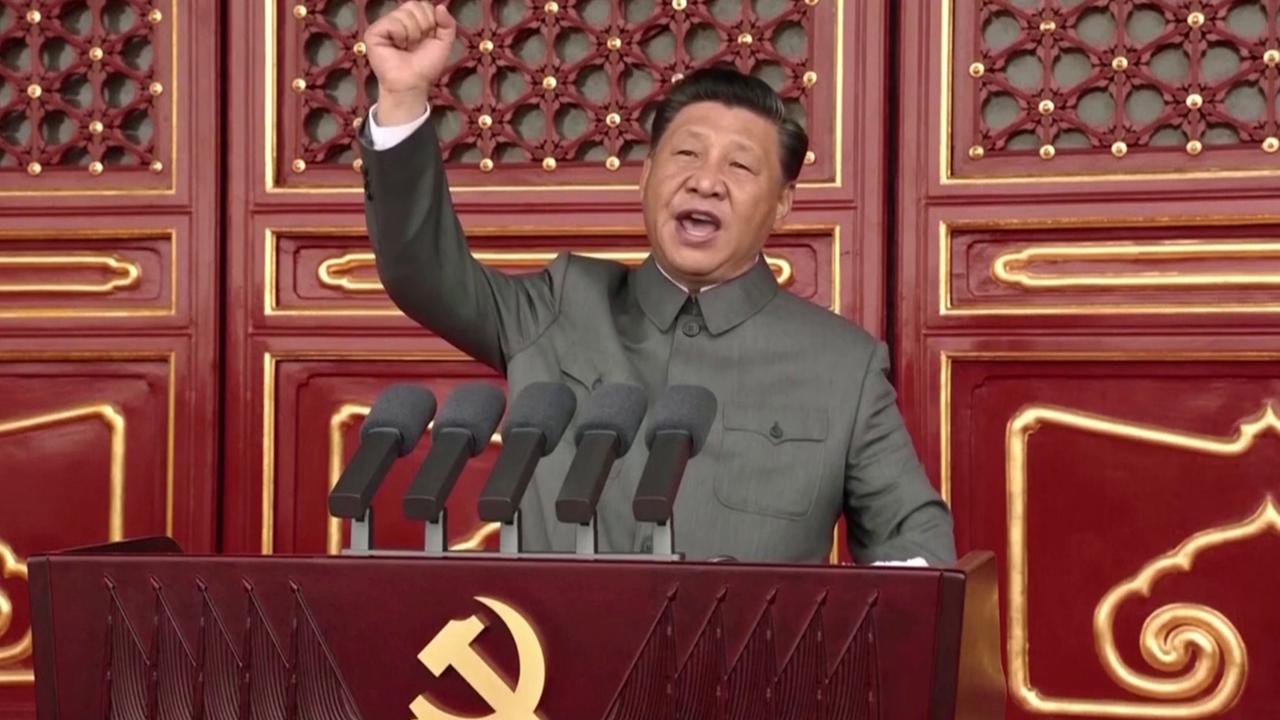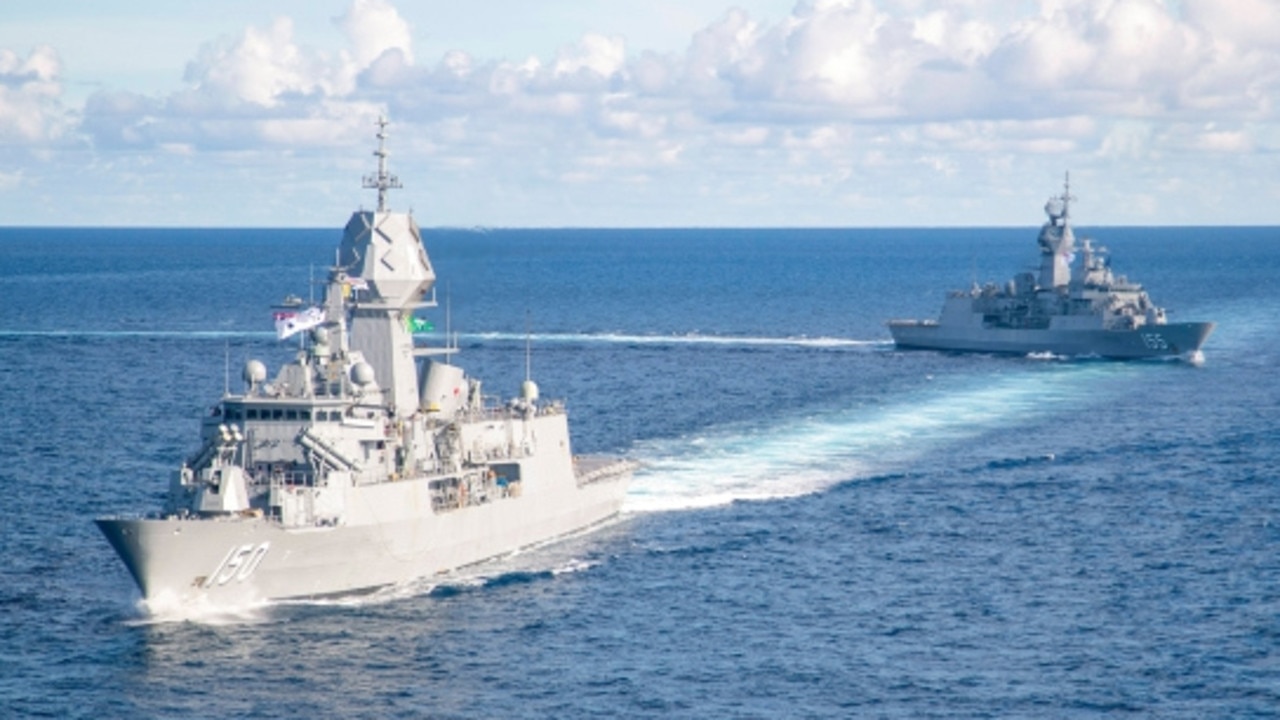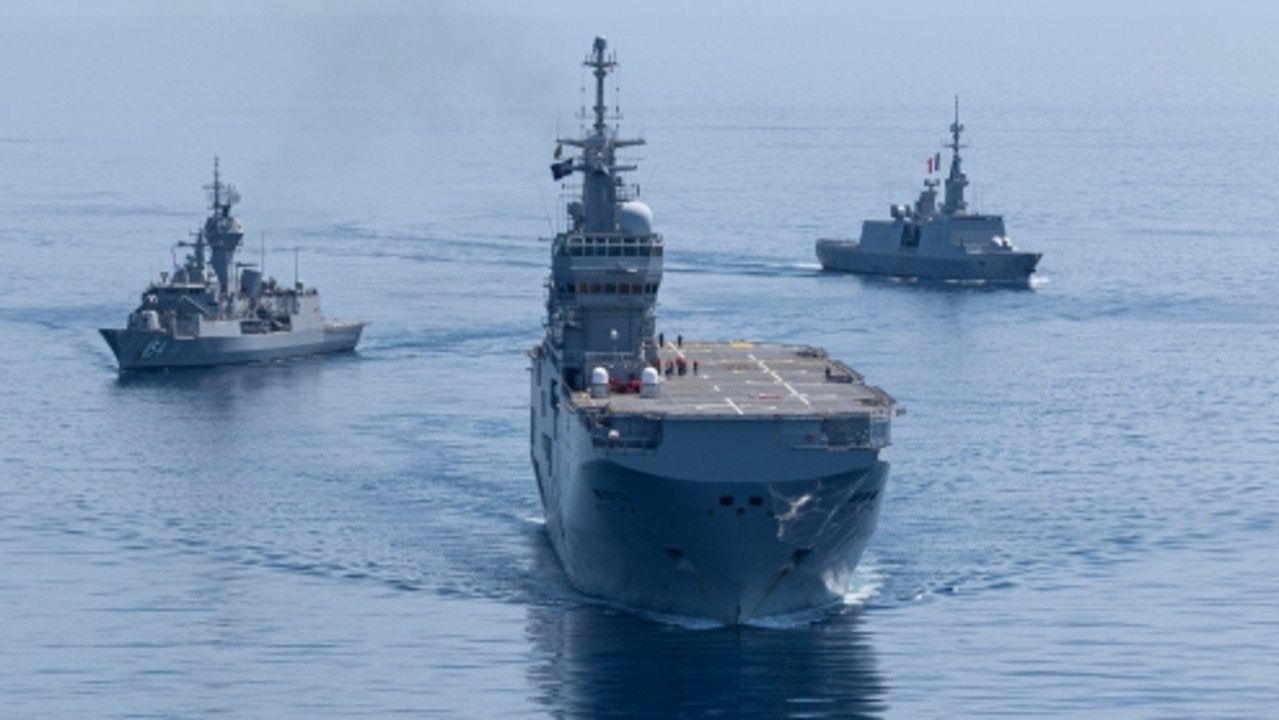Is Australia’s involvement in South China Sea conflict worth it?
A heated Chairman Xi Jinping made a stark promise about what would happen to “bullies” of China. Yet Canberra seems intent on interfering.
More warships. More heated words. Australia seems set on a course for deadly confrontation with China in the South China Sea. Is it worth it?
Chairman Xi addressed a 70,000 strong crowd in Tiananmen Square on Thursday to kick off the Chinese Communist Party’s centenary celebrations.
It was a momentous occasion — a spectacular event.
He was in no mood for contradiction.
Xi stridently warned interfering international “bullies” would “have their heads banged against a Great Steel Wall forged by more than 1.4 billion Chinese”.
“We will never allow anyone to intimidate, oppress or subdue China. No one should underestimate the determination, will and ability of the Chinese people to defend their national sovereignty and territorial integrity,” he said.
This was met with thunderous applause by the massive crowd.
RELATED: 50,000 troops rushed to China border

Meanwhile, Canberra seems intent on “interfering”.
It has sent the Royal Australian Navy (RAN) five times in the past six months to challenge Beijing’s unilateral assertion of ownership over the South China Sea. It’s planning on conducting several more such missions in coming weeks.
That’s almost double last year’s effort.
“It’s been a long time coming, in my view,” says UWA defence studies director Professor Peter Dean.
“The new focus is actually getting us back to core business, which is the South Pacific and Southeast Asia.”
The executive director of LaTrobe Asia, Dr Bec Strating, says Canberra wants the world to get more involved in Southeast Asia. And it’s leading by example.
“Australia has been somewhat of a canary in the coal mine,” she says.
“We’ve been the target of Beijing’s economic sanctions since 2012. So the world sits back and goes, ‘how is Australia going to respond to this?’”
Scrap Iron Flotilla
Australia may have an answer to Chairman Xi’s “Great Steel Wall”.
It’s a “Scrap Iron Flotilla”.
That’s the insult hurled by Nazi Propaganda Minister Joseph Goebbels at a collection of five old RAN destroyers sent to serve in the Mediterranean during the opening years of World War II.
Australian sailors embraced the label with pride.
The modern RAN is not significantly bigger than it was then. But it’s still busy on the frontline against authoritarianism. In March, the frigate HMAS Anzac and the support ship HMAS Sirius breached China’s “Nine Dash Line”. Anzac went on to exercise with the Japanese destroyer JS Akebono.
In April, Anzac and Sirius jointly operated with the French amphibious assault ship FS Tonnerre and frigate FS Surcouf in the South China Sea and the Indian Ocean.
In May, Anzac and Sirius were joined by the frigates HMAS Ballarat and HMAS Parramatta.
Then, in July, Ballarat spent a week in contested waters with the destroyer USS Curtis Wilbur. This included live-fire gunnery war games.
RELATED: China doubles down in troubled sea

Beijing’s wolf warrior diplomats were not impressed.
Foreign Ministry spokesperson Wang Wenbin said both countries should “do things that are conducive to regional peace and stability, instead of flexing their muscles.”
Meanwhile, it was busy flexing its own muscles in the Spratly Islands and around Taiwan.
But Professor Dean says Canberra’s not all that interested in the barking of wolf warriors.
“They’ll call us a lackey or whatever,” he says.
“There’ll be a lot of overblown rhetoric like we’re used to hearing. What’s really important is how the PLAN (People’s Liberation Army Navy) understands these moves and responds to them.”
But the South China Sea is rapidly turning into a cauldron.
And Australia’s warships are in the thick of it.
‘Wolf Warriors’ versus ‘Warhounds’
Australia’s warships have been singled out in Beijing’s belligerent threats.
In December, the Global Times news service expressed anger at “evil” Australia’s interference.
“As a warhound of the US, Australia should restrain its arrogance. Particularly, its warships must not come to China’s coastal areas to flex muscles, or else it will swallow the bitter pills,” its editorial warned.
Dr Straton says Australia has so far been cautious in balancing the equation of risk versus reward. But China’s repeated threats could be wearing thin.
“Beijing has been very willing to use economic coercion tactics against Australia, and it hasn’t significantly damaged the Australian economy – at least yet. So maybe the calculation has shifted. But of course, the other fear is about putting personnel and vessels at risk.
“There are significant risks involved in doing something new and in doing something provocative,” she adds.
Those risks appears to be perpetually rising.
RELATED: ‘We can bomb’: Tense standoff at sea

“You’re getting more warships, more aircraft there,” Professor Dean explains. “And of course, we’ve also got more fishing vessels, and we’ve got more container ships. So it’s getting to be a more congested environment. And that in itself can raise the risk.”
He says Australia has avoided directly challenging sovereign boundaries, valid or not. But nor is it backing away.
“We’ve been in the South China Sea for 100 years. Ever since the Royal Australian Navy was established, it has been part of our region. We’ve never not been there. What’s new is the belligerence of the Chinese in objecting to our presence.”
Which is why he believes Canberra must remain defiantly “normal”.
“I’m one of the people who think consecutive Australian Governments – both Coalition and Labor – have pretty much got this balance right. Basically, Australia’s stance is that we will not stop doing what we’ve been doing. But what we won’t do is unilaterally provoke any increase in tensions.”
Friends like us
Beijing’s neighbours find themselves in a challenging position. Like Australia, they have strong economic ties to China. They’re also no match as individual military powers.
“They want to exert their sovereignty,” Professor Dean says. “They want to be able to maintain their access. They don’t believe in the Nine-Dash Line. But standing up to Beijing is very difficult for them”.
Signs of pushback are emerging.
But every Southeast Asian nation has its own ideas about how to do so. And its own interests to sustain.
This, Professor Dean says, is why Canberra’s policy of not engaging in assertive US-style Freedom of Navigation Operations (FONOPS) has been the correct course to follow.
“Will doing FONOPS inside those 12 nautical miles stop the Chinese from occupying those islands? No. Could it upset our partners? Yes. So what is it really going to achieve?”
Dr Strating says Canberra instead wants to deepen relations within the region by conducting routine cooperative security operations of the type it has always done. Its engagement with external world powers is about defending the rules-based order.
“I mean, the number one security challenge or security threat as perceived by Australia is the rise of China,” Dr Strating said.
Two RAN warships will be joining Britain’s new aircraft carrier, HMS Queen Elizabeth, as it sails through the South China Sea in coming months.
Britain’s colonial past, however, has “history”. And Australia, by joining in, will be associating itself with those unhappy memories.
“But at the heart of Australia’s Indo-Pacific concept is the need to co-ordinate with so-called ‘like minded states’ who share values around things like the rules-based order,” Dr Strating says.
“That doesn’t mean that there aren’t risks associated with being seen as a lapdog of the United States. And there are some potentially problematic optics with working with former colonial powers. But Australia sees the bigger challenge as countering China’s rise and preserving the status quo US-led order”.
As a middle-sized power, Canberra needs friends.
Such joint operations prove it has them.
Diplomatic minefield
Why should Canberra stick its neck out in the South China Sea?
“Australia has the world’s third-largest exclusive economic zone,” Dr Strating says. “And that is granted by virtue of international law. So it’s a national interest for us that this system of laws remains legitimate and stable.”
And China is the “dominant actor challenging the maritime rules-based order within the South China Sea.”
Professor Dean believes shifting Australia’s warship patrols out of the Persian Gulf to the South China Sea is the proper signal to send. As is refusing to comply with Washington’s pressure to push Beijing’s buttons with FONOPS challenges to its artificial islands.
“We’re not taking a step backwards. We’re not recoiling from our international obligations or what we believe in. But, at the same time, the US Navy can do all the FONOPS that they like. It is not going to change the outcome of what is the new status quo in the South China Sea.”
And Australia’s not just “tagging along” with other nations’ forces.
It’s actively engaging with the region by inviting them to exercises in Australian territory. Later this month, South Korea is for the first time sending troops and a destroyer to join the Talisman Sabre war games with the United States, New Zealand, Canada, the UK and Japan.
Operation Indo-Pacific Endeavour kicks off again this year. In August, two RAN warships will visit friendly nations – and unfriendly regions – throughout Southeast Asia.
“The purpose is the training element, the interoperability and proving ability,” says Dr Strating.
“They’re doing all that kind of capabilities stuff. But then it’s also about being present in the region, reassuring partners that Australia is there, and increasing co-operation and defence diplomacy.”
And Canberra has its reasons for doing so.
“Australia’s activities in the region contribute to the US Alliance, but in deepening relations with Indo-Pacific partners, Australia is also hedging against dependence on either the US or China.”
Jamie Seidel is a freelance writer | @JamieSeidel




